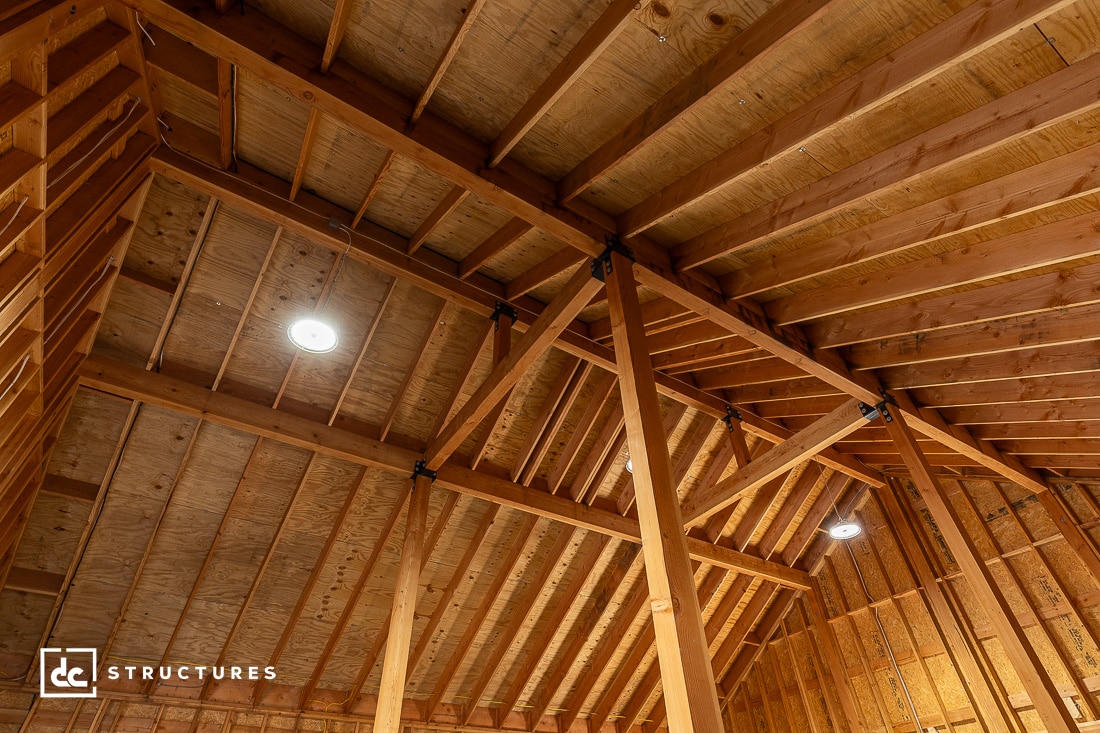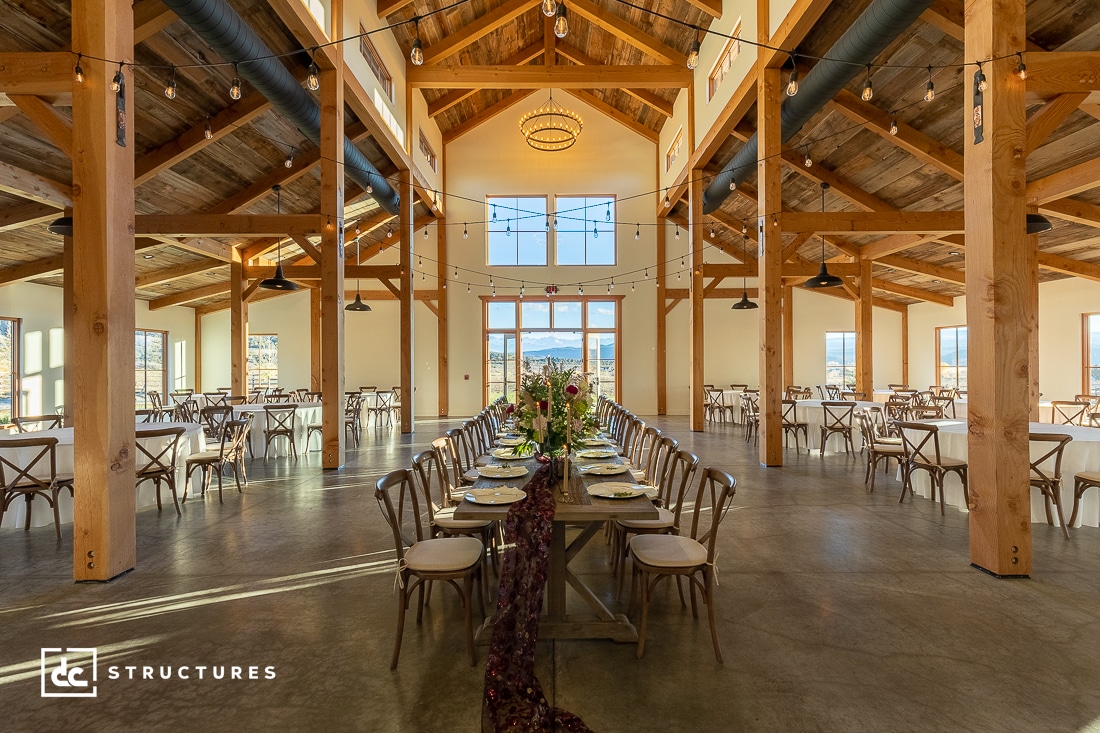Navigating the complex vocabulary of barn construction can be a daunting task. While familiarizing yourself with industry terms like “dormers” and “cupolas” is useful, it’s crucial to understand a few fundamental concepts before embarking on your barn project. Notably, “post and beam construction” and “post-frame construction” are two construction methods often mistaken for one another due to their similar names. At DC Builders, we offer both as framing options for our barn kits, each with distinct advantages and drawbacks.
What is Post and Beam Construction?
Post and beam construction is a centuries-old building practice that utilizes heavy timbers joined by metal fasteners to form the frame of a structure. Like timber framing, post and beam construction uses large timbers in place of dimensional lumber to create dramatically open interiors that are generally free of structural constraints. Due to the strength of these heavy timbers, post and beam structures do not require load-bearing walls to support the upper floors and roof system. This construction method also sees that the exterior walls of the building are positioned on the outside of the frame. As a result, our clients can enjoy the look of exposed wood members in nearly every area of their barn.
The Pros of Post and Beam
Aside from their obvious beauty, there are several benefits to building a post and beam barn on your property, including:
Structural Integrity
One of the major selling points of this construction style is its superior structural integrity, considering post and beam buildings are some of the most durable structures built today. At DC Structures, we use select-grade Douglas fir — one of the best wood types for residential and commercial construction in North America — as our standard framing material for our post and beam structures. Grown here in the Pacific Northwest, these specialty timbers will keep your barn standing strong and looking beautiful for generations to come.
Design Freedom
Another notable benefit to post and beam construction is its open-ended design, considering there are no pesky load-bearing walls to work around inside your building. With only minimal wood posts to consider as part of your design, you have complete freedom to do as you wish with your interior area. The lack of load-bearing walls in a post and beam building also means clients can place their windows, doors, and horse stalls wherever they see fit in their space. With this extra flexibility, you can explore endless options for your barn interior.
Efficient Construction
Lastly, our post and beam barn kits make construction easy and efficient for our clients and their builders. Thanks to our Simple Build System, every piece of framing lumber used to create your exterior walls, floor components, and roof arrives pre-cut, drilled, and labeled on your job site. As a result, our clients can enjoy a framing process that takes far less time, money, and labor than a conventionally framed structure while guaranteeing the highest quality results for your project.
The Cons to Post and Beam
Upfront Cost
While there are minimal setbacks to building a post and beam barn for your property, something that can deter people from investing in a post and beam structure is their upfront cost. Because post and beam buildings are more costly to construct than many metal-built, stick-built, and post-frame barns, these structures may be out of reach for some buyers interested in building a barn kit. However, it’s worth mentioning that post and beam buildings are far more likely to retain their appearance and durability over time than cheaper alternatives, making them a long-lasting, worthwhile investment for those who can afford their initial price tag. With a post and beam barn, you can expect your structure to last you decades, if not centuries while increasing in value over time.
What is Post Frame Construction?
Commonly associated with pole barns, post-frame structures are pre-engineered, wood-framed buildings that typically use large pressure-treated wood posts or laminated columns to create the structural frame. This construction method relies on the strength of its wood posts or columns to support the upper floors and roof system, with these members often embedded directly in the ground or added on a monolithic slab. Many low-rise buildings like warehouses and agricultural facilities are post-frame structures, considering these buildings tend to employ heavy-duty trusses to create wide-open expanses free of interior posts or walls. In fact, when combined with clear span truss construction, a post-frame building provides the ideal framework for an indoor riding arena, as it ensures riders can enjoy an unobstructed and protected space for them and their horses.
The Pros of Post Frame
Open Interiors and Ease of Construction
Like post and beam construction, post-frame construction is known for its open interiors and ease of construction. Thanks to its interlocking frame and support columns, a post-frame structure does not require load-bearing walls, resulting in wide-open interiors that are malleable to one’s vision. Post-frame buildings are also easy to construct, considering these structures are often pre-engineered to facilitate a fast and efficient framing process.
Cost-Effectiveness
A big reason why people like post-frame barns is because these structures offer a low-cost yet wide-ranging alternative to other more costly building methods. Because post-frame barns require fewer structural materials than post and beam and conventionally-framed structures, these buildings are usually much cheaper and faster to build by comparison. This construction method is also suitable for large, low-rise buildings, making it the ideal solution for commercial, agricultural, and industrial applications. With its versatile interiors, durable framework, and relatively inexpensive price tag, post-frame buildings are a worthy consideration for many buyers in the market for a barn.
The Cons to Post Frame
Structural Limitations
Although post-frame barns might seem like a better investment than post and beam structures to some, there are a few downsides to these buildings that buyers should be aware of before making their decision. For instance, post-frame buildings are typically designed as low-rise structures due to their simple framework and cheap cost to build. While these structures can function as multi-level buildings, their minimal structural frame makes it so that any significant design changes like adding an upper level or basement would require major engineering upgrades and structural modifications that would drive up the overall building cost.
In essence, what you see is what you get in many ways with post-frame structures. That being said, our designers can always work with your design, location, and need requirements to ensure your post-frame structure looks and performs according to your vision.
Regional Suitability
In addition to its structural constraints, post-frame structures aren’t naturally suited to every location. These structures are mostly constructed in regions with temperate climates, as their standard frame isn’t built to adequately handle heavy snow loads, tornadoes, or other extreme weather events. Even so, there are ways to protect your structure in any event, namely by utilizing larger timbers and rafters as part of your design or adding reinforcements to your foundation, siding, or roof material. Again, this will drive up the cost of your final building package. However, with DC designing your post-frame structure, you can trust our team to deliver a quality solution that tackles these setbacks and more.
Making Your Decision
The choice between a post and beam barn and a post-frame barn ultimately comes down to your preference and the plans you have for your structure. If you’re seeking an economical building that’s generally easy and cheap to construct, a post-frame barn may be the right solution for its intended purpose. However, if you’re looking for a more durable, well-rounded structure with endless versatility, a post and beam barn could be the perfect addition to your lot.
DC Structures has a proven record of success in designing and producing wood structures that last. Take a look at our catalog to see how we can transform your vision into a reality.






